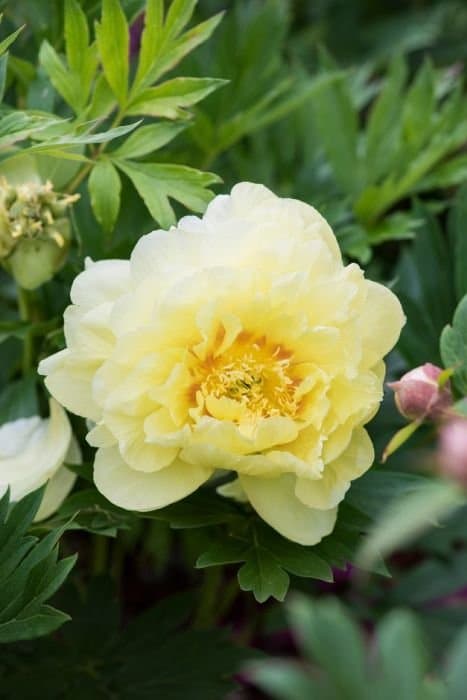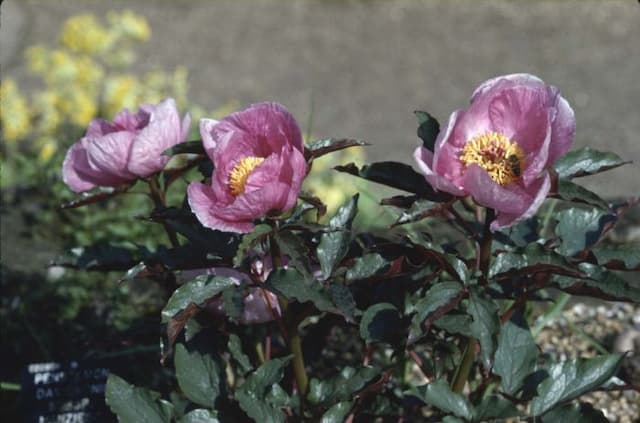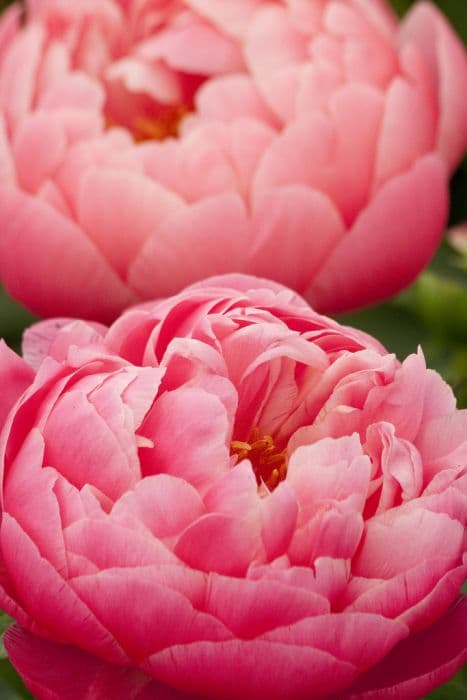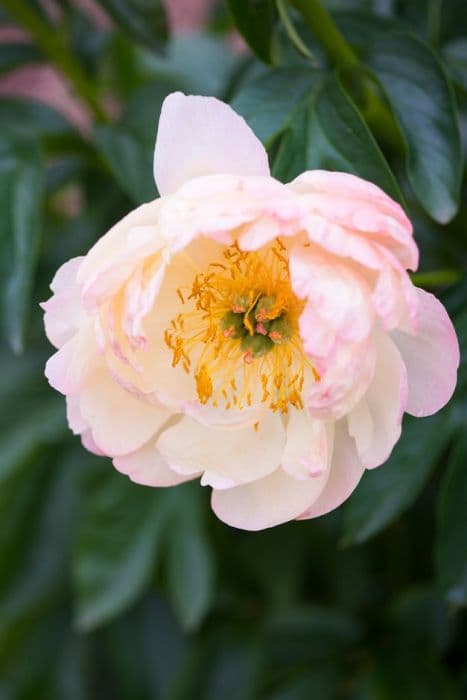Peony 'Otto Froebel' Paeonia peregrina 'Otto Froebel'

ABOUT
'Otto Froebel' is an erect herbaceous perennial to 60cm in height, with glossy dark green, divided foliage and single, vermilion flowers 10-12cm in width, with orange-yellow stamens
About this plant
 Names
NamesSynonyms
Otto Froebel Peony, Otto Froebel's Peony, Red Peony
Common names
Paeonia peregrina var. huthii, Paeonia humilis var. peregrina, Paeonia corallina var. peregrina, Paeonia moutan-var. peregrina.
 Characteristics
CharacteristicsLife cycle
Perennials
Foliage type
Deciduous
Color of leaves
Green
Flower color
Red
Height
2 feet (60 cm)
Spread
2 feet (60 cm)
Plant type
Herb
Hardiness zones
4
Native area
Southeastern Europe
Benefits
 General Benefits
General Benefits- Ornamental Value: Paeonia peregrina 'Otto Froebel', commonly known as the peony, has large, attractive blooms that add a splash of color to gardens in the spring.
- Pollinator Attraction: The flowers are known to attract bees and other pollinators, thereby supporting local ecosystems.
- Durability: Peonies are hardy perennials, often living for many years and surviving through harsh winters with minimal care.
- Easy to Grow: Peonies, including 'Otto Froebel', are relatively easy to cultivate and can thrive in a wide range of soils, though they prefer well-drained loam.
- Seasonal Interest: Adds interest to the garden with its beautiful flowers in the spring and lush green foliage throughout the growing season.
- Cut Flowers: The blooms are ideal for cut flower arrangements, maintaining their beauty and structural integrity for several days indoors.
- Heritage Plant: Many peony varieties have been cultivated for centuries, and growing them helps to preserve these historical horticultural varieties.
- Low Maintenance: Once established, peonies require very little maintenance, other than occasional feeding and deadheading.
- Deer Resistance: Peonies are generally resistant to deer, which can be beneficial for gardeners in areas with high deer populations.
- Variety of Colors and Forms: 'Otto Froebel' peonies offer a bold red hue, but peonies as a group come in many colors and forms, adding versatility to garden design.
 Medical Properties
Medical PropertiesThis plant is not used for medical purposes.
 Air-purifying Qualities
Air-purifying QualitiesThis plant is not specifically known for air purifying qualities.
 Other Uses
Other Uses- Paeonia peregrina 'Otto Froebel', commonly known as peony, can be used in the production of perfumes due to its strong, pleasant fragrance.
- Its petals can be crystallized and used as edible decorations for cakes and desserts to add a touch of elegance.
- The peony's large blooms can be utilized in art classes for botanical drawing lessons, emphasizing their intricate structures and colors.
- As a natural dye, the petals of peony flowers can be boiled to extract a range of colors for use in textile and craft projects.
- These flowers can be used in photography, as their vibrant colors and large size make them an excellent subject for still life images.
- In the language of flowers, peonies are often used to express bashfulness or compassion, making them suitable for inclusion in messages conveyed through bouquets.
- Peony flowers can be floated in large decorative bowls of water to create elegant and simple centerpieces for events or home decor.
- Dried peony petals can be incorporated into homemade potpourri mixtures for a natural and fragrant home scent.
- Peonies can be used as a natural pest repellent in gardens due to their toxicity to certain insects, without harming beneficial insects like bees.
- Their sturdy stems and voluminous blooms make peonies ideal as natural supports for other, more delicate plants within a mixed border or floral arrangement.
Interesting Facts
 Feng Shui
Feng ShuiThe Peony is used in Feng Shui practice to attract love and romance, and is often recommended to be placed in the southwest corner of the garden or home.
 Zodiac Sign Compitability
Zodiac Sign CompitabilityThe Peony is not used in astrology practice.
 Plant Symbolism
Plant Symbolism- Prosperity: Peonies often symbolize wealth and honor, embodying a wish for a prosperous life.
- Beauty: With its lush, full, rounded bloom, peonies are often associated with beauty in all forms.
- Romance: The lush and fragrant flowers of peonies are frequently tied to romantic love and are popular in bridal bouquets.
- Good Fortune: Peonies symbolize good luck, making them a popular gift, especially in the context of marriage or new beginnings.
- Nobility: In historical China, peonies were often linked with regal dignity and opulence, making them a flower of the aristocracy.
- Compassion: Some traditions associate the peony with compassion due to its lush, nurturing appearance.
- Honor: Particularly known in Japanese culture, the peony can represent honor and bravery, especially because warriors used to be decorated with peony motifs.
 Water
WaterPeonies like the Paeonia peregrina 'Otto Froebel' should be watered deeply once a week, ensuring that the soil is moist but not waterlogged. During the growing season, particularly if the weather is dry, increase watering to every 4 to 5 days. Apply approximately one gallon of water per plant per watering session to properly saturate the root zone. Reduce watering in the fall as the plant prepares for dormancy, and during the winter, water sparingly, just enough to prevent the soil from drying out completely.
 Light
LightPeonies such as Paeonia peregrina 'Otto Froebel' thrive in full sun to partial shade. They perform best with at least 6 hours of direct sunlight per day. A location that receives morning sun and afternoon shade is ideal, particularly in hot climates where intense afternoon sun can be detrimental to the blooms.
 Temperature
TemperaturePeonies like Paeonia peregrina 'Otto Froebel' prefer temperate climates with winter chill for dormancy. They can generally withstand winter temperatures as low as -20°F and summer temperatures up to 90°F, but they flourish in spring and fall temperatures ranging from 65°F to 75°F. Avoid exposing peonies to temperatures above 90°F for prolonged periods as it can stress the plant.
 Pruning
PruningPeonies like Paeonia peregrina 'Otto Froebel' should be pruned to remove spent blooms after flowering to maintain a tidy appearance and prevent seed development, which can sap energy from the plant. In the fall, after the foliage has died back, cut the stems down to within a few inches of the ground to prepare for winter and to reduce the risk of disease. Annual pruning is sufficient for peonies.
 Cleaning
CleaningAs needed
 Soil
SoilThe best soil mix for Peony 'Otto Froebel' consists of well-draining loam with added organic matter such as compost. The pH should be slightly acidic to neutral, ranging from 6.0 to 7.0, to allow optimal growth and bloom development.
 Repotting
RepottingPeonies, including 'Otto Froebel', seldom require repotting as they prefer to be left undisturbed. They may only need repotting if they outgrow their space or after many years when the soil is depleted.
 Humidity & Misting
Humidity & MistingPeony 'Otto Froebel' tolerates a range of humidity levels and does not require high humidity. Average ambient humidity found in most outdoor garden environments is suitable for this plant.
 Suitable locations
Suitable locationsIndoor
Place in bright spot, avoid overheating, water sparingly.
Outdoor
Full sun, well-drained soil, protect from high winds.
Hardiness zone
3-8 USDA
 Life cycle
Life cycleThe life of a Paeonia peregrina 'Otto Froebel', commonly known as Otto Froebel Peony, begins with seed germination, which occurs in early spring after a period of stratification to break dormancy. The emerging seedling develops a root system and a shoot that grows into a juvenile plant with characteristically divided leaves. As the peony matures into its vegetative stage, it develops a stout, herbaceous stem and a larger rootstock or tuber that enables it to endure winter dormancy under the soil. Upon reaching maturity, which can take several years, the Otto Froebel Peony typically blooms in late spring to early summer, producing large, aromatic flowers that can be red, pink, or white. After pollination, usually by insects, the plant produces fruit in the form of follicles that contain seeds, which are dispersed by gravity and potentially by animals. The plant then enters a period of senescence in late autumn, with aerial parts dying back to the ground before winter, completing one life cycle with the rootstock surviving to regenerate the following spring.
 Propogation
PropogationPropogation time
Spring-Early Summer
Propogation: The common name for Paeonia peregrina 'Otto Froebel' is the peony, and it is most popularly propagated by division. This is typically done in the fall after the plant has gone dormant. The process involves digging up the root ball of the mature plant and carefully separating it into sections, each with at least three to five buds and a good amount of root attached. The divisions are then planted in well-draining soil at a depth where the buds are 1 to 2 inches (2.5 to 5 centimeters) below the surface. It’s crucial to provide adequate water to the newly planted divisions to help them establish, but one must avoid overwatering as peonies do not like soggy soil. Dividing peonies can rejuvenate older plants, improve flowering, and is an excellent way to multiply the number of plants in your garden.









